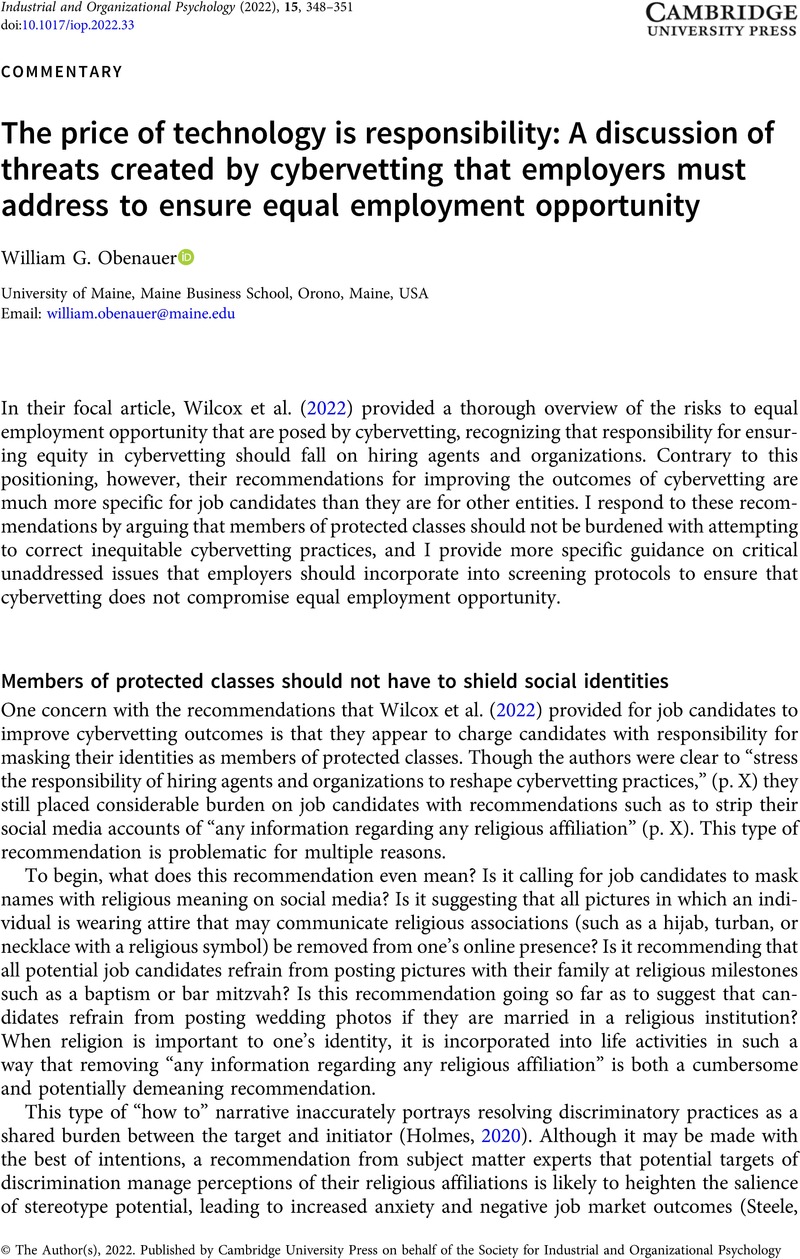No CrossRef data available.
Article contents
The price of technology is responsibility: A discussion of threats created by cybervetting that employers must address to ensure equal employment opportunity
Published online by Cambridge University Press: 09 September 2022
Abstract
An abstract is not available for this content so a preview has been provided. Please use the Get access link above for information on how to access this content.

- Type
- Commentaries
- Information
- Copyright
- © The Author(s), 2022. Published by Cambridge University Press on behalf of the Society for Industrial and Organizational Psychology
References
Equal Employment Opportunity Commission. (1992). A technical assistance manual on the employment provisions (Title I) of the Americans with Disabilities Act. https://www.eeoc.gov/laws/guidance/technical-assistance-manual-employment-provisions-title-i-americans-disabilities-act
Google Scholar
Henderson, R. (1991). Addiction as disability: The protection of alcoholics and drug addicts under the Americans with Disabilities Act of 1990. Vanderbilt Law Review, 44(3), 713–740.Google Scholar
Holmes, O., IV. (2020). Police brutality and four other ways racism kills Black people. Equality, Diversity and Inclusion, 39(7), 803–809. https://doi.org/10.1108/EDI-06-2020-0151
CrossRefGoogle Scholar
Leonard, J. S., Levine, D. I., & Joshi, A. (2004). Do birds of a feather shop together? The effects on performance of employees’ similarity with one another and with customers. Journal of Organizational Behavior, 25(6), 731–754. https://doi.org/10.1002/job.267
Google Scholar
Mook, J. R., & Powell, E. E. (1996). Substance abuse and the ADA: What every employer should know. Employee Relations Law Journal, 22(2), 57–78.Google Scholar
National Institute on Alcohol Abuse and Alcoholism. (2021). Understanding alcohol use disorder. https://www.niaaa.nih.gov/sites/default/files/publications/Alcohol_Use_Disorder.pdf
Google Scholar
Obenauer, W. G., & Langer, N. (2019). Inclusion is not a slam dunk: Astudy of differential leadership outcomes in the absence of a glass cliff. Leadership Quarterly, 30(6), Article 101334. https://doi.org/10.1016/j.leaqua.2019.101334
CrossRefGoogle Scholar
Steele, C. M. (1997). A threat in the air: How stereotypes shape intellectual identity and performance. American Psychologist, 52(6), 613–629. https://doi.org/10.1037/0003-066X.52.6.613
CrossRefGoogle ScholarPubMed
U.S. Department of Justice. (2020). Questions and answers: The Americans with Disabilities Act and hiring police officers. https://www.ada.gov/copsq7a.htm#:∼:text=An individual with alcohol use, individual with alcohol use disorderGoogle Scholar
Wilcox, A., Damarin, A. K., & McDonald, S. (2022). Is cybervetting valuable? Industrial and Organizational Psychology: Perspectives on Science and Practice, 15(3), 315–333.Google Scholar




